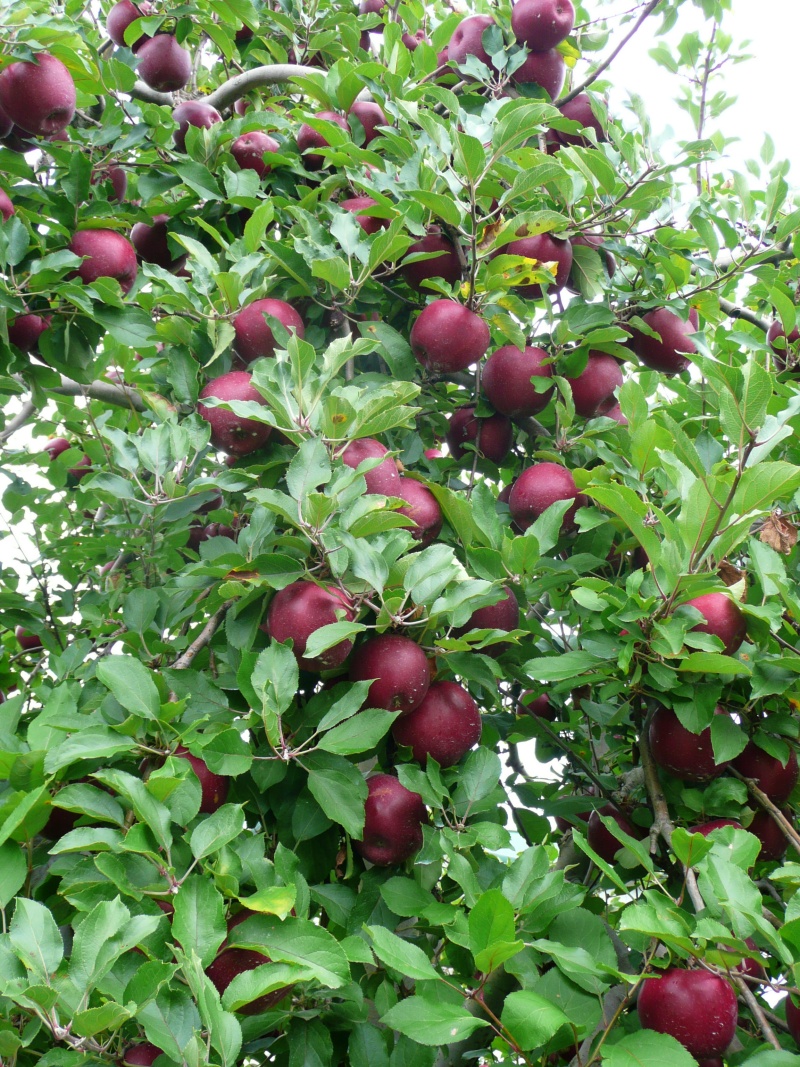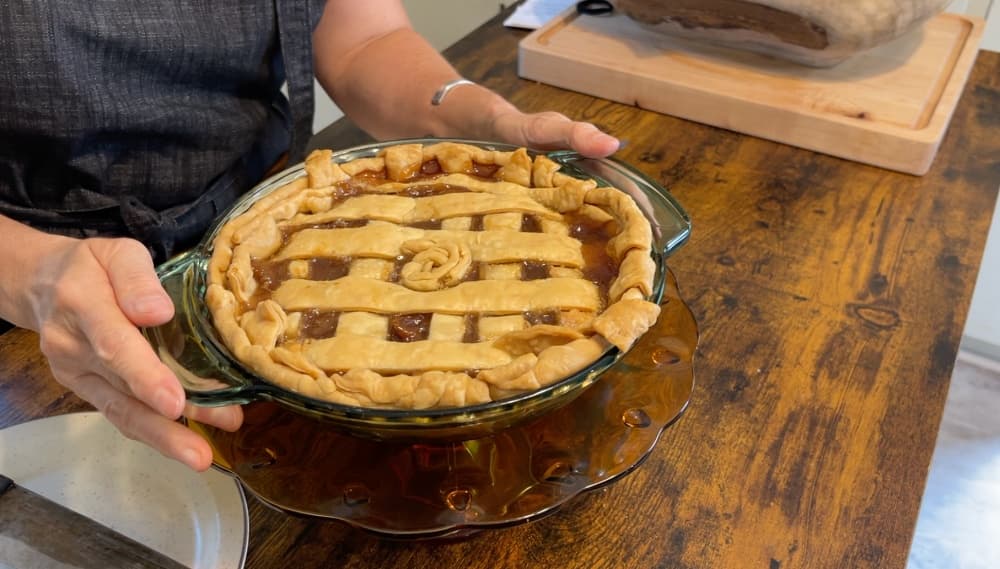SWEET SEPTEMBER

A September sunset in the Smokies
That scent is, for me, as alluring as any Chanel perfume. It is comprised of a hint of ragweed, a pinch of red clay dust, a tincture of gun oil, and the essence of something better experienced in person than described in print. All I know is that I can smell fall just as surely as I know the intense singing of jar flies (cicadas) and katydids heralds the fact that we are on the cusp between summer and fall.
Then there’s the bounty of fall, and it is found not only at the meals which are an integral part of dove shoots but on the tables of anyone fortunate enough to live close to the good earth. In my garden fall raspberries are ripe, and brown turkey figs literally ooze honey-like sweetness as they hang limp in full ripeness. There’s the final crop of corn just coming in, oozing milk as so sweet it is wonderful eaten raw. Nor should watermelons and muskmelons be forgotten, while okra thriving in the heat of dog days demands regular cutting.

Sunrise in a dove field in early September
Meanwhile, it’s a good time to be out and about in the deer woods. Woodlands cry out for a September saunter to check out stands, do a bit of scouting, or merely savor thoughts of those coming rites of fall. Nature’s bounty approaches the fullness of the season as well. Soon the first white oak acorns will be dropping; already persimmons are showing hints of the yellow which will in due course turn from alum tartness to spicy orange sweetness, and paw paws are beginning to ripen.
Night times are carrying a hint of cool and the humidity seems slightly less oppressive. Up in the high country where I spent much of this summer, brown trout will become increasingly restless, somehow knowing what lies ahead, and they feed readily on grasshoppers and other terrestrial insects. Rainbows too are quite active, although with both species the season demands long casts, delicate delivery, and light tippets. If you aren’t a fly fisherman, things are picking up with warm water species as well. Bass begin to chase schooling bait, slashing the surface and bringing back the joys of topwater action that one knew back in May.
We are well into September, and simple mention of the month is enough to add a bit of pep to my step and send my spirits soaring. Here are some of the reasons why I hail sweet September.
*I salute the month because it brings katydids singing in the dew of dawn and the dusty cool of coming night as if there was no tomorrow. In some senses they are right, because once you hear them offering an insect equivalent of a hallelujah chorus fall and much lower temperatures don’t lie too far away. If you are mathematically inclined you can listen to katydids and figure out the air temperature. Just count the number of chirps in a minute, subtract 40, divide the result by four, and then add 60. Of course consulting a thermometer might be quicker and simpler.
*Muscadines and scuppernongs are hanging ripe on vines where some leaves are already yellowing, as are fox grapes up in the high country where I was raised. That means all sorts of culinary delights such as fox grape jelly, sucking the goodness from a golf ball-sized muscadine fresh from the vine, or the indescribable delights of a hull pie (see the recipes below and you might also want to check out Tipper Pressley’s “Celebrating Appalachia” YouTube video from the middle part of this month. In it she makes a scuppernong pie using grapes I supplied and a recipe from my most recent book, Fishing for Chickens: A Smokies Food Memoir).

Three generations of the Turner family gathered for one of the last of the family’s “big” shoots.
As the banner in the background shows, the first hunt was held in 1949
*Mere mention of a scuppernong pie puts my salivary glands into overdrive, because this delicacy is inextricably linked in my mind with the opening day of dove season and glad moments connected with that landmark event in yesteryear before my cherished friend, Roy Turner, died. Some cooking genius in his extended family always had a couple of hull pies made for the pre-hunt feast. Incidentally, it was my first sampling of that delicacy that led to me going a bit crazy over muscadines years ago (scuppernongs are a sort of subset of muscadines—all scuppernongs are muscadines, but not all muscadines are scuppernongs). As I result I’ve got perhaps 300 feet of trellised vines and each year I have literally dozens of gallons of grapes go to waste.
*The arrival of September means it’s time to begin to bid summer adieu while welcoming gradually cooling nights. Thoughts of the glories of October now seem within reach—a welcome contrast to the situation on a sweltering July day. You know whitetail season is just around the corner, that squirrels will be cutting hickory nuts in no time at all, and that before long you can be out and about in the middle of the day without being miserable.
*September is the time to gather hazelnuts, check black walnut trees in anticipation of harvesting their offerings in a few weeks, make a visit to the pawpaw patch (I’ve got a big one on some land I own), and gather in pretty much all that is left of the garden truck. It’s time to pull up hot pepper plants from the roots and hang them from a barn rafter to dry. Handled this way they’ll keep right through the winter and be ready to provide tangy flavor to soups, stews, pinto beans and the like. You can even make tea from dried hot peppers (my Grandpa Joe did it all the time and would smack his lips in delight as he slurped from “sassered” tea hot enough in both taste and temperature to set you afire). It’s not my cup of tea, but he swore by it even as beads of sweat speckled his sparsely haired head.

A tree laden with apples in mid-September–it’s pickin’ time
*It’s apple picking time, and for someone with mountain roots like me, apples have always been THE fruit of fall. We had a small orchard when I was a boy, and it’s amazing just how much fruit a small number of properly tended trees can produce. Many of my favorite desserts involve apples.
*September is a riot of color. It’s sumac and dogwood leaves turning red; the berries atop Devil’s club showing a hue of purple rivaled only by that of ironweed abloom in pastures; and the flowers of fall—wild asters, goldenrod, cardinal flowers, and many more—in all their vibrant showiness. It’s mist hugging the ground on a cool morning. It’s dust devils dancing across bone-dry fields in the mid-afternoon sun. It’s time alone on a trout stream where stealth and precise casting are at a premium. As one casts he can contemplate the coming spawning movements of big browns and dream good dreams of October. September is the comfort of a campfire in the backcountry and the first hints of yellow on hickories and poplars It’s a time when nature’s eye candy becomes irresistibly fetching, even though it is a mere harbinger of greater glories to come.
Obviously there is a great deal which is mighty sweet about September, and I’ll conclude with wishes to the effect that I hope you enjoy the month as a whole as much as I do. For all its myriad glories, maybe the finest thing about the month is that it heralds coming October, a time so full of promise of in terms of what it means for the hunter as well as signaling another season of earth’s annual cycle of growth winding its way to an end.
JIM’S DOIN’S
As I have noted in previous newsletters, Tipper Pressley and I are working on a cookbook. We are in the short rows on it from the standpoint of the work involved, with the manuscript having been submitted, photographs chosen, and work on the cover information finalized. The title of the book will be Celebrating Southern Appalachian Food: Recipes and Stories from Mountain Kitchens. It’s a joint effort in every sense. I haven’t counted to get an exact total but each of us contributed scores of recipes. I did the majority of the work on the narrative material while Tipper has carried the load when it comes to supporting photographs. She’s got a far better eye and is a far better photographer than I am.
I have no idea of what the final price of the book will be but know it will be quite reasonable. I’m guessing somewhere in the $20-$25 range. The publisher, The History Press, is known for producing quality books at comparatively low prices. If you want to be put on a list to be notified when the work is available (I’m guessing sometime in the first half of 2023) just drop me an e-mail now and I’ll be sure you hear.
Speaking of Tipper and books, I had the delightful opportunity to sit down with her for a half hour chat on her “Celebrating Appalachia” YouTube channel. She offers videos several times a week and if you want a refreshing and interesting taste of life in the region, past and present, these presentations, along with those on her daily “Blind Pig and the Acorn” blog are both informative and entertaining. We ranged fairly widely in the video I did with her, although its primary focus is on my book, Fishing for Chickens: A Smokies Food Memoir. If you go to “Celebrating Appalachia” and listen to and watch me ramble and ruminate, you’ll discover, as I did, that I’m about as bad as my beloved Grandpa Joe when it comes to “talking” with my hands. They are busy punctuating, gesticulating, emphasizing, and just waving about throughout the entire chat.
The month also brought a talk with a group of gracious ladies in a garden club in Columbia. They were a wonderful audience and being among them sharing stories from a life lived close to the good earth was a grand reminder of how that connection is something we all can (and should) enjoy in common.
On a quite different front, an ever dwindling number of my classmates from high school got together for a reunion. My high school and my senior class were small (well under a hundred students in the graduating class), and as I remarked at the gathering, I consider each and every member of that class friends for life. There’s something about growing up in a small, close-knit, and in my case relatively impoverished community that binds folks together. I might also note that when I asked those present whether they thought life was better today or all those decades ago when we were all living in an Appalachian backwater in what was defined, on the national level, as something approaching abject poverty, every person present opted for old long ago. Maybe that’s just age, but quite possibly it’s also a somewhat sad commentary on today’s world and way of life.
As usual, my writing work moves along at the best pace I can manage. That translates to a weekly column in the Smoky Mountain Times; “Fish on the Table,” South Carolina Wildlife, Sept./Oct., 2022, pp. 36-39 (this magazine always makes me look good thanks to the consistent appeal of its artwork); a piece, “In Praise of Porches,” Columbia Metro, Sept., 2022, pp. 102-08, that looks with longing on the wonders of times spent on porches while talking, peeling apples, working up beans, and the like; and two on-line offerings, “The Delights of Vegetable Mixes,” “Smoky Mountain News,” Sept. 9, 2022, and “Hazel Creek,” “The South on the Fly,” Sept., 2022.
LAUGHTER IS LIFE

It’s a little early for a Christmas story, but since I mentioned this episode in my recent video appearance on “Celebrating Appalachia” (mentioned above) I thought I’d go ahead and share it. The Yuletide season was a really big deal in my youth, and for all the excitement it brought to my siblings and me, that was matched if not exceeded by Momma. She had a rough childhood, with her mother dying when she was an infant and her father essentially abandoning her sister and her to be raised (separately) by kinfolks. As a result, I don’t think she ever had much in the way of a real holiday celebration as a kid, but she sure made up for it as a mother and an adult. Come the Christmas season she would be as excited as any child on a candy “high,” and various doings at church, cooking, decorating, and any and all activities associated with the season drew her irresistibly.
That certainly included gifts, and as presents started to stack up around the family tree she would make repeated visits to check on packages bearing her name. The temptation to lift them, maybe shake the box a bit, and stare at it in wonder held her as enthralled as a six year old.
At this juncture it needs to be noted that gag gifts were an integral part of Christmas in our family. From Mickey Mouse boxer underwear for Dad one holiday to a primitive stick-and-string fire starter for me on another (testament to my singularly shameful neglect in venturing deep into the back country of the Smokies without matches), there was always something to evoke good-natured laughter. Momma and the mysteriously noisy box were about to intersect in a classic gag gift scenario.
She was so intrigued that on Christmas morning, as the ritual of opening presents commenced, she anxiously awaited her turn as each of several grandchildren who were present opened a gift. Then, when some adult suggested she ought to be the first grown person to continue the process, she latched onto the box like a catfish on a bait of chicken liver. Paper and ribbon flew, but that only led to a second box where the process was repeated. Only then were the gift and the source of all the noise revealed. It was a box of dry pinto beans labeled “Smoky Mountain Bubble Bath.” Momentarily mystified and then aware that she had been pranked, Momma shook her head in dismay, remained silent for a time, then came about as close as I ever heard to an expletive. “Oh, foot!” she said, and then joined everyone else in raucous laughter.
RECIPES
SCUPPERNONG PIE—RECIPE 1
This offering is what is often known as a hull pie. Squeeze pulp from ripe scuppernongs or muscadines and discard inside (or save it to make jelly). Do this gently in order to retain as much of the juicy, sweet flesh attached to the hull. Do this until you have a pint of hulls. Add three-fourths cup of sugar and stir in. Cook over gentle heat until tenderized, adding half teaspoon of almond flavor and a half stick of real butter as you do so. Once tenderized, add cornstarch to thicken and as mixture begins to cool, pour over pie crust.
SCUPPERNONG PIE—RECIPE 2

This is the recipe Tipper Pressley made on her “Celebrating Appalachia” video. It utilizes both the hulls and the pulp of the grapes.
3 or 4 cups of scuppernongs or muscadines
Water
1 cup sugar (or slightly more if needed)
2 tablespoons cornstarch
3 tablespoons butter
Cinnamon or apple pie spice
Pastry for a two-crust pie
Pre-heat oven to 300 degrees. Wash grapes. Use two medium-sized enamel saucepans, squeezing pulp into one and placing the hulls in the other. Cover hulls with water, cook until tender, and then drain. Cook pulp until soft enough to run through sieve to remove seeds. Add to hulls. Mix sugar and cornstarch. Add scuppernong mixture and dot with butter. Sprinkle with spice. Pour into pastry-lined pie pan, cover with strips of pastry, and bake until golden brown.
SMOKY MOUNTAIN STYLE SCALLOPED POTATOES
Maybe streaked meat doesn’t qualify as a condiment, but in the culinary world in which I grew up, behind only salt and black pepper, it in effect served that purpose. From mustard greens to milk gravy, from any type of dried legume to standard garden vegetables, a chunk or two of this salty portion of pork with its many names—streak o’ lean, side meat, fat back, middlin’ meat, and others—was a staple for mountain cooks. There might have been minor differences as regards where it came from on home-butchered hogs, but when all was said and done it was salt pork laden with fat and flavor. It added savor to countless dishes, not to mention serving as an accompaniment to cornbread or a taste changer in milk gravy for what were purt nigh meatless meals. When it came to a dish of scalloped potatoes, it was the culinary equivalent of lace on the bride’s pajamas.
Peel and slice enough potatoes (most any type will work, although mountain traditions would have leaned towards Kennebecs, Idahos, or Russets) to fill your baking dish close to full. For purposes of even cooking, try to make the slices all the same size. Of course if your kitchen utensils include a mandoline slicer you have that problem solved.
1 large Vidalia onion (optional) sliced quite thin
Cream sauce. Preparing the cream sauce should not be intimidating. Begin by making a roux using grease from the streaked meat and flour in the same skillet in which you fried the meat, stirring briskly with a whisk until you have the desired consistency. Then add milk (and cheese if desired), continuing to stir, until you have a nice, smooth sauce. Be sure it isn’t too thick, and as is the case with gravy you can control that by the addition of liquid (in this case, milk).
Several slices of streaked meat, cut quite thin and fried crisp prior to beginning preparation on the scalloped potatoes (save the grease from frying the meat).
Seasonings such as chopped chives or parsley, black pepper, and sparsely used flakes or dried cayenne pepper to taste. DO NOT add salt if using streaked meat. It carries a lot of salt in its own right. You can always add salt to taste with individual servings but you can’t rectify over salting.
Layer the ingredients, beginning with potato slices, then onion, cream sauce, and streaked meat. Sprinkle spices atop each complete layering of ingredients. Your final or top layer should be potatoes. Cover with foil and bake at 375 degrees until the potatoes test tender with a fork. Remove the foil and return to the oven for a few more minutes to give an eye catching brown to the dish. Allow to set for 15 minutes after taking from the oven so the sauce can thicken.
TOMATO AND ONION PIE
Years ago a cousin, Joyce Casada Bryant, brought this dish to a family reunion. It drew rave reviews in a setting where a whole bunch of splendid cooks annually vied to outdo one another. With summer now at an end, maybe you’ve got a few tomatoes still hanging on. If so, give this recipe a try.
INGREDIENTS
1 refrigerated pie crust
8 ounces shredded mozzarella cheese
2 tablespoons chopped basil
4 large tomatoes, cored, peeled and sliced ½ inch thick
1 large Vidalia onion, sliced
½ teaspoon salt
¼ teaspoon black pepper
1/8 cup extra virgin olive oil
Fit the crust in a pan and spread the cheese over the crust. Sprinkle with basil and then top with slices of onions and tomatoes. Sprinkle with salt and pepper and then drizzle with the olive oil. Bake for 30 (or a bit longer if the pie is “shaky”) minutes in a 400-degree oven. Slice and serve.
VIDALIA ONION CASSEROLE
Throughout my life I’ve heard the term “sweet onions” applied to assorted varieties of this traditional mountain root crop, but in my view the description is a misnomer. Admittedly some onions grown in the high country have less bite than others, but none are truly sweet. Certainly no onions from mountain gardens come close to those produced in the special soil and agricultural circumstances found in counties around the south-central Georgia town of Vidalia. These onions, truly worthy of being categorized as sweet, are readily available in your local grocery throughout the year. While you can substitute other sweet onions in this recipe, none quite match the rightly heralded Vidalia strain. This is a recipe that requires considerable time, thanks primarily to the fact that slow is the way to go when it comes to caramelizing onions, but it is worth every minute expended in preparation.
6 to 8 onions, sliced quite thin (use a mandoline or ulu to make slicing simpler)
½ stick of butter
Black pepper to taste
½ teaspoon salt
¼ cup sour cream
¼ cup mayonnaise (do not use light mayo)
¼ cup grated or granulated Parmesan cheese
1 cup grated sharp or extra sharp cheddar cheese
15 to 20 Ritz or Saltine crackers, crushed
Preheat a large, non-stick skillet and once it is hot add butter, sliced onions, salt, and pepper. Sauté the onions for 45 to 60 minutes over low heat, stirring every few minutes, until they are soft and begin to take on a golden “see through” glow. You don’t want the heat high enough to brown the onions as they cook down and caramelize.
Once the onions are translucent, dump them into a large plastic bowl and mix in the sour cream, mayonnaise, and cheeses. Stir the ingredients together and then use a spatula to scrape the mixture into a baking dish that has been coated with cooking spray. Top with the cracker crumbs and bake at 375 degrees for a half hour or until the casserole bubbles and is gold on top.